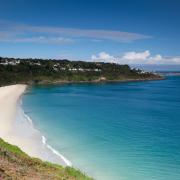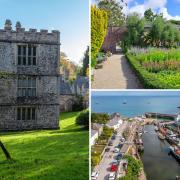
Famed for its painters - the visual arts is only half the story, as Truro and Penwith College lecturer Jackie Harding explains Cornwall’s literary connections are as varied as they are wide
Although Cornwall is most often associated with visual art and surfing, its literary heritage is equally exciting. Writers have always been drawn to our romantic coasts and desolate moorland. Daniel Defoe toured the wilderness of the Cornish peninsula at around the time he was writing one of the first English novels, Robinson Crusoe. Is it too farfetched to suggest that footprints on a remote Cornish beach led him to Man Friday?
More than a hundred years earlier an Elizabethan courtier, Richard Carew, wrote about theatre in Cornwall in his survey of 1602, an original edition of which can be found in The Cornish Studies Library in Redruth. Carew’s attitude to the Cornish players was patronising and dismissive but his account reveals that the rich thread of anarchic community theatre and pageant in Cornwall is at least 500 years old.

The Mediaeval Cornish Language plays, The Ordinalia Cycle and Beunans Meriasek, The Camborne Play’ reveal that large scale community involvement in storytelling and drama was, in fact, part of a much earlier tradition that was hijacked by the monks at Glasney College in Penryn as part of their mission to convert the pagans. You only need to witness one of the wonderfully magical and mysterious woodland shows regularly performed in Tehidy Woods by Rogue Theatre to question whether the monks were entirely successful.
Place names, even in somewhere as prosaic as Camborne, hint at the Celtic paganism that persists. Druids Road leads off the industrial estate at the foot of Carn Brea where the landscape bears witness to the battles giants Zennor and Morvah fought in ancient times. These folk tales were recorded in the nineteenth century by William Botrell and Robert Hunt and so the oral tradition was preserved.
The mythical otherness of Cornwall was picked up by aristocratic Victorian writers Tennyson and Swinburne who took advantage of the new railways to explore Cornwall, now an accessible wilderness, a shortcut to the sublime. Tennyson developed the myth of King Arthur at Tintagel and Swinburne heard the echoes of knights’ tournaments in the wind coming off the wild seas.
It was not only rich English visitors who were inspired by the landscape and stories of Cornwall. John Harris was a miner at Dolcoath for nearly thirty years, from the age of nine, walking dawn and dusk across the scarred landscape at the foot of Carn Brea. Incredibly he published 17 volumes of poetry, hymns, plays and stories in which he dramatizes like no-one before the reality of working underground and the hardships endured by the working people among whom he lived who were buoyed up by their stoical faith. Harris also dramatized the mythical pre-Christian world he felt around him For me the rocks have language,’ he said.
Harris only left Cornwall once and his work was forgotten for nearly a century until re-discovered by Nobel Laureate D M Thomas, who grew up in the same village as Harris and who, like him, found inspiration in the myths and romance of the rugged landscape around Carn Brea. Thomas’s work is, of course, considerably racier than that of Bible reader Harris!
In his poetry, Thomas Hardy revisited Cornwall and his first love throughout his life. Virginia Woolf’s descriptions of a child casting shadows on a rock pool must reflect her experiences on beaches nearby.
Dylan Thomas was married in Cornwall and listeners can hear voices from the intricate network of cottages and alleyways in Mousehole in the lyrical realism of Under Milk Wood. While living near Zennor during World War I, DH Lawrence and his German wife Frieda, cousin of The Red Baron, were accused of spying but that did not prevent him from writing short stories inspired by his observations of the landscape and people around him.
Daphne du Maurier’s novels draw tourists from around the world who want to trace the footsteps of the naïve Rebecca and the murderous wrecker Joss Merlyn. More recently Poldark draws those in search of romance.
Playwrights, actors, film makers and novelists seeking a creative space continue to throng to Cornwall. At St Ives Arts Club every Thursday evening writers and musicians gather under the benign protection of Bob Devereux to perform their work at the Frug. Satirical rappers Hedluv and Passman from Redruth rub shoulders with aspiring and published poets. Writers from Truro and Penwith College, who are studying Creative Writing as part of a degree in English Literature, brave the stage and share their work in the very room where the young Virginia Woolf gazed at her lighthouse while her mother played the piano and where artists have gathered to share their ideas since 1890.


























